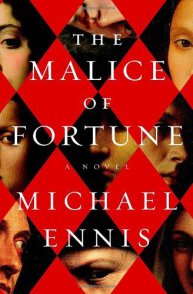

★★
It’s 1502. Women are being murdered in the Romagna, and their deaths may hold the secret to a mystery that has plagued Pope Alexander VI: the brutal murder of his beloved son Juan, Duke of Gandia. Eager for revenge, he sends an agent north to find out more. The former courtesan Damiata arrives in the town of Imola, the headquarters of the Pope’s second son Cesare, with a powerful motivation to succeed: her infant son is being kept as a hostage at the Borgia court. Yet she isn’t the only one seeking the truth about these murders. Two others are also trying to identify the killer: one is the put-upon Florentine envoy, Niccolò Machiavelli; the other is Cesare’s engineer-general, the Tuscan polymath Leonardo da Vinci.
The three investigators have a formidable task in front of them. The bodies of the women have been found in neatly-divided fragments, each accompanied by a little bollettino with a riddling quote upon it. These extracts suggest that the placement of the bodies is eerily playful, based on geometrical division of Leonardo’s aerial map of Imola. But who has access to the map? Both Niccolò and Leonardo fear that the condottieri are involved, as part of a plot to frustrate Cesare’s plans for a new Italy. In this new world, peace and concord would replace the factionalism of years past, and there would be no further place for the condottieri and their petty wars. Niccolò wants to defeat them because the triumph of the condottieri would mean destruction for his beloved Florence, which has earned the enmity of the powerful Vitellozzo Vitelli. And Leonardo wants to encourage the new world envisioned by Cesare, which will be built to his own plans for cleaner, rational and just cities.
As they work, Leonardo and Niccolò are made opposing theorists. The former espouses a mathematical approach (by measuring the proportions of the bodies, we can determine which parts belong together, and understand the game the killer is playing with us; although, I noted, Leonardo doesn’t actually come up with any clever ideas about how to catch the killer); while Niccolò believes it should be possible to identify the man by psychological means, and by comparing him to the great tyrants of the past (cunningly anticipating Machiavelli’s political works).
It doesn’t require much imagination to see why I was attracted by this novel. I’m not a big fan of historical murder mysteries, but I couldn’t resist the idea of Machiavelli and Leonardo working together to solve a crime. The addition of Cesare Borgia simply added spice to the prospect. In the end, however, the book didn’t quite live up to its promise. That’s partly because the solution to the mystery was given away in one of the reviews I read – don’t worry, I won’t do that here. But it was also due to the rather stilted quality of the writing and to the fact the author presents this as a novel accurate in all its details, whereas in fact I feel there’s a good proportion of creative interpretation going on here.
My problem, I suppose, is that I’ve read too much about Leonardo and I have very fixed ideas about what he was, or should be, like. Ennis has captured one side of his character very well: the precise, inquisitive, mathematical quality of his thought, and his entirely unsentimental quest for the proportions that govern and illuminate Nature’s laws. But this Leonardo is ruthlessly empirical, unable to relate to people, the kind of man who speaks in bursts taken from his own notebooks, a kind of cross between a particularly irritating Sherlock Holmes and a Vulcan. Where is the other side of Leonardo, attested in so many sources: the fanciful, charming fabulist, creator of allegories and riddles, every inch the urbane courtier? I was, however, pleased to see both Tommaso Masini and Salaì (Giacomo) making appearances. Neither had much space for characterisation, but Salaì came across as decorative and not particularly useful, which sounds about right.
Moreover, I didn’t really buy the whole premise of the novel. It felt as though Ennis had started with the code – the map, the concept, the geometrical positions – and worked out from there, as opposed to making everything grow naturally from the characterisation. I simply never believed that even the most soulless serial killer would bother with such a complicated, involved game – and I certainly didn’t believe that such a man would have given up his precious self-control to partake in a pagan ritual which could unmask him against his will. The situation felt over-engineered and occasionally needlessly gruesome.
At root, I suppose I never really felt convinced enough by the characters and situations to care very much. The victims are (with one exception) nameless, expendable characters, women who exist only to be dismembered and scattered across the landscape. Their fate matters more than who they actually are, which made me feel slightly uneasy, but also points to the fact this book is more of an intellectual puzzle than a gripping, heart-pounding thriller. It’s also one of those by-now-cliched works whose raison d’être is to ‘reveal’ a shocking secret beneath the surface of some great work of European culture. Not for me, alas. I think Ennis wants this book to be The Da Vinci Code meets The Name of the Rose meets Scandi-noir, which doesn’t really do it for me, but may appeal to other readers who haven’t developed such fixed ideas of what these historical characters ‘ought to be’ like.
I actually already have Ennis’s other Renaissance novel on my to-read pile – Duchess of Milan. I’m certainly still going to read it, as it seems to be more of a character piece than this, but perhaps I’ll manage my expectations when I come to it…
Buy the book
Share this:




